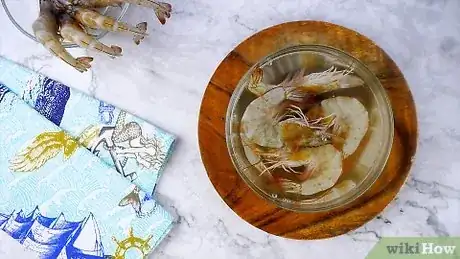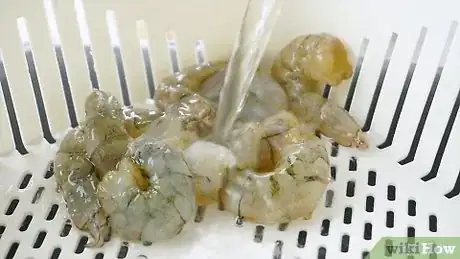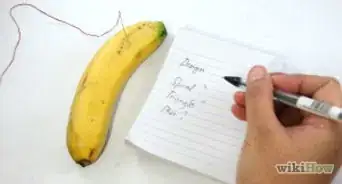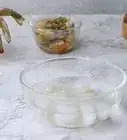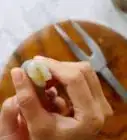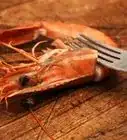This article was co-authored by Abyssinia Campbell and by wikiHow staff writer, Danielle Blinka, MA, MPA. Abyssinia Campbell is an Executive Chef and the Owner of Chef Abyssinia, Personal Chef and Catering. With over ten years of experience, she specializes in catering, event planning, menu development, meal planning, and food business operations. When it comes to cooking, Chef Abyssinia enjoys using fruits, vegetables, healthy food alternatives, and local farm-fresh ingredients. She holds a BASc in Culinary Arts and Food Service Management from Johnson and Wales University.
There are 10 references cited in this article, which can be found at the bottom of the page.
This article has been viewed 59,841 times.
Peeling your own shrimp is a great way to save money and enjoy more flavorful dishes. It’s super easy to peel shrimp with items you already have in your kitchen. We’ll tell you all you need to know to peel raw, frozen, or cooked shrimp quickly so you can get to the good part—eating them! You'll actually follow the same steps for peeling any type of shrimp, so let's get started.
Things You Should Know
- Thaw frozen shrimp in cold water before peeling.[1]
- Keep the shrimp in ice water while you are peeling.
- Remove the head first, then legs, then the shell. You may also remove the tail before cooking if you'd like, but many prefer to leave it on.
Steps
Expert Q&A
-
QuestionHow do you keep shrimp from shrinking when cooking?
 Abyssinia CampbellAbyssinia Campbell is an Executive Chef and the Owner of Chef Abyssinia, Personal Chef and Catering. With over ten years of experience, she specializes in catering, event planning, menu development, meal planning, and food business operations. When it comes to cooking, Chef Abyssinia enjoys using fruits, vegetables, healthy food alternatives, and local farm-fresh ingredients. She holds a BASc in Culinary Arts and Food Service Management from Johnson and Wales University.
Abyssinia CampbellAbyssinia Campbell is an Executive Chef and the Owner of Chef Abyssinia, Personal Chef and Catering. With over ten years of experience, she specializes in catering, event planning, menu development, meal planning, and food business operations. When it comes to cooking, Chef Abyssinia enjoys using fruits, vegetables, healthy food alternatives, and local farm-fresh ingredients. She holds a BASc in Culinary Arts and Food Service Management from Johnson and Wales University.
Executive Chef You cannot prevent them from shrinking completely. However, you can make them shrink less (and taste better) by not overcooking them. You can also buy larger shrimp, and you can leave the tail on to make shrimp look bigger.
You cannot prevent them from shrinking completely. However, you can make them shrink less (and taste better) by not overcooking them. You can also buy larger shrimp, and you can leave the tail on to make shrimp look bigger. -
QuestionBoiled shrimp are very hard to peel. What do I do?
 Community AnswerUse the "fork trick." Stick a fork tine in the shrimp from the front end down along its back, and "unzip" it with an upward motion. This opens up the shell, and the shrimp will come out.
Community AnswerUse the "fork trick." Stick a fork tine in the shrimp from the front end down along its back, and "unzip" it with an upward motion. This opens up the shell, and the shrimp will come out. -
QuestionCan you boil shrimp?
 Community AnswerYes. Boil them for about eight minutes, then cool them in the fridge and peel them.
Community AnswerYes. Boil them for about eight minutes, then cool them in the fridge and peel them.
Things You’ll Need
- Large mixing bowl of cold water (for frozen shrimp only)
- Colander
- Baking sheet
- Clean towel or paper towel
- Bowl of ice
- Paring knife
- Fork (optional)
- Deveining tool (optional)
Warnings
- Keep your shrimp on ice so they don’t spoil while you’re peeling them.⧼thumbs_response⧽
References
- ↑ https://www.fsis.usda.gov/food-safety/safe-food-handling-and-preparation/food-safety-basics/big-thaw-safe-defrosting-methods
- ↑ https://www.simplyrecipes.com/recipes/how_to_peel_and_devein_shrimp/#toc-how-to-quick-thaw-frozen-shrimp
- ↑ https://www.recipetips.com/kitchen-tips/t--1239/how-to-prepare-and-devein-shrimp.asp
- ↑ https://www.recipetips.com/kitchen-tips/t--1239/how-to-prepare-and-devein-shrimp.asp
- ↑ https://www.fao.org/3/x5931e/x5931e01.htm
- ↑ https://www.taste.com.au/entertaining/articles/how-to-peel-and-devein-prawns/peoefbue
- ↑ https://savortheflavour.com/peel-devein-shrimp/
- ↑ https://www.allrecipes.com/recipe/263417/shrimp-stock/
- ↑ https://www.fao.org/3/x5931e/x5931e01.htm
- ↑ https://www.taste.com.au/entertaining/articles/how-to-peel-and-devein-prawns/peoefbue
- ↑ https://www.recipetips.com/kitchen-tips/t--1239/how-to-prepare-and-devein-shrimp.asp
- ↑ https://www.myrecipes.com/how-to/do-you-really-need-to-devein-your-shrimp
- ↑ https://www.taste.com.au/entertaining/articles/how-to-peel-and-devein-prawns/peoefbue
- ↑ https://www.consumerreports.org/fish-seafood/are-shrimp-good-for-you-a6470516712/
- ↑ https://www.recipetips.com/kitchen-tips/t--1239/how-to-prepare-and-devein-shrimp.asp
- ↑ https://www.fda.gov/food/buy-store-serve-safe-food/selecting-and-serving-fresh-and-frozen-seafood-safely
About This Article
To peel shrimp, start by gently twisting the head until it pops off. Then, dig your thumb under the shell to help it release from the meat. Once the shell comes loose, hold the tail and pull the shell off. If you want to remove the tail too, pinch it at the bottom, where it connects to the body, and give it a gentle tug. You can also use kitchen shears to cut through the shell and pull it off, though doing this may cut some of the shrimp meat too. For tips on how to clean your shrimp, keep reading!
